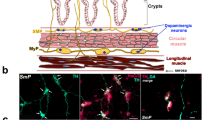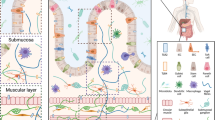Abstract
Background
Leucine-rich repeat kinase 2 (LRRK2) is a recently discovered molecule associated with familial and sporadic Parkinson’s disease. It regulates many central neuronal functions such as cell proliferation, apoptosis, autophagy, and axonal extension. However, in contrast to the well-documented function of LRRK2 in central neurons, it is unclear whether LRRK2 is expressed in enteric neurons and affects the physiology of the gut.
Aims
By examining LRRK2-KO mice, this study investigated whether enteric neurons express LRRK2 and whether intestinal neuronal peptides and IgA are quantitatively changed.
Methods
Intestinal protein lysates and sections prepared from male C57BL/6 J mice were analyzed by Western blotting and immunostaining using anti-LRRK2 antibody, respectively. Intestinal neuronal peptide-mRNAs were quantified by real-time PCR in wild-type mice and LRRK2-KO mice. Intestinal IgA was quantified by ELISA. Lamina propria mononuclear cells (LPMCs) were analyzed by flow cytometry to evaluate the ratio of B1 to B2 B cells.
Results
Western analysis and immunostaining revealed that LRRK2 is expressed in enteric neurons. The amounts of mRNA for vasoactive intestinal peptide, neuropeptide Y, and substance P were increased in LRRK2-KO mice accompanied by an increment of IgA. However, the intestinal B cell subpopulations were not altered in LRRK2-KO mice.
Conclusions
For the first time, we have revealed that LRRK2 is expressed in enteric neurons and related to quantitative alterations of neuronal peptide and IgA. Our study highlights the importance of LRRK2 in enteric neurons as well as central neurons.





Similar content being viewed by others
References
Funayama M, Hasegawa K, Kowa H, Saito M, Tsuji S, Obata F. A new locus for Parkinson’s disease (PARK8) maps to chromosome 12p11.2-q13.1. Ann Neurol. 2002;51:296–301.
Funayama M, Hasegawa K, Ohta E, et al. An LRRK2 mutation as a cause for the parkinsonism in the original PARK8 family. Ann Neurol. 2005;57:918–921.
Paisán-Ruíz C, Jain S, Evans EW, et al. Cloning of the gene containing mutations that cause PARK8-linked Parkinson’s disease. Neuron. 2004;44:595–600.
Barrett JC, Hansoul S, Nicolae DL, et al. Genome-wide association defines more than 30 distinct susceptibility loci for Crohn′s disease. Nat Genet. 2008;40:955–962.
Franke A, McGovern DP, Barrett JC, et al. Genome-wide meta-analysis increases to 71 the number of confirmed Crohn′s disease susceptibility loci. Nat Genet. 2010;42:1118–1125.
Zhang FR, Huang W, Chen SM, et al. Genomewide association study of leprosy. N Engl J Med. 2009;361:2609–2618.
Meylan E, Tschopp J. The RIP kinases: crucial integrators of cellular stress. Trends Biochem Sci. 2005;30:151–159.
Higashi S, Moore DJ, Colebrooke RE, et al. Expression and localization of Parkinson’s disease-associated leucine-rich repeat kinase 2 in the mouse brain. J Neurochem. 2007;100:368–381.
Liu Z, Lee J, Krummey S, Lu W, Cai H, Lenardo MJ. The kinase LRRK2 is a regulator of the transcription factor NFAT that modulates the severity of inflammatory bowel disease. Nat Immunol. 2011;12:1063–1070.
Kubo M, Kamiya Y, Nagashima R, et al. LRRK2 is expressed in B-2 but not in B-1 B cells, and downregulated by cellular activation. J Neuroimmunol. 2010;229:123–128.
Moehle MS, Webber PJ, Tse T, et al. LRRK2 inhibition attenuates microglial inflammatory responses. J Neurosci. 2012;32:1602–1611.
Hakimi M, Selvanantham T, Swinton E, et al. Parkinson’s disease-linked LRRK2 is expressed in circulating and tissue immune cells and upregulated following recognition of microbial structures. J Neural Transm. 2011;118:795–808.
Esteves AR, Swerdlow RH, Cardoso SM. LRRK2, a puzzling protein: insights into Parkinson’s disease pathogenesis. Exp Neurol. 2014;261:206–216.
Martin I, Kim JW, Dawson VL, Dawson TM. LRRK2 pathobiology in Parkinson’s disease. J Neurochem. 2014;131:554–565.
Furness JB. Types of neurons in the enteric nervous system. J Auton Nerv Syst. 2000;81:87–96.
Coelho-Aguiar Jde M, Bon-Frauches AC, Gomes AL, et al. The enteric glia: identity and functions. Glia. 2015;63:921–935.
Schemann M. Control of gastrointestinal motility by the “gut brain”—the enteric nervous system. J Pediatr Gastroenterol Nutr. 2005;41:S4–6.
Genton L, Kudsk KA. Interactions between the enteric nervous system and the immune system: role of neuropeptides and nutrition. Am J Surg. 2003;186:253–258.
Neunlist M, Van Landeghem L, Mahé MM, Derkinderen P, des Varannes SB, Rolli-Derkinderen M. The digestive neuronal-glial-epithelial unit: a new actor in gut health and disease. Nat Rev Gastroenterol Hepatol. 2013;10:90–100.
Vu JP, Million M, Larauche M, et al. Inhibition of vasoactive intestinal polypeptide (VIP) induces resistance to dextran sodium sulfate (DSS)-induced colitis in mice. J Mol Neurosci. 2014;52:37–47.
Margolis KG, Stevanovic K, Karamooz N, et al. Enteric neuronal density contributes to the severity of intestinal inflammation. Gastroenterology. 2011;141:588–598.
Duffy LC, Zielezny MA, Riepenhoff-Talty M, et al. Vasoactive intestinal peptide as a laboratory supplement to clinical activity index in inflammatory bowel disease. Dig Dis Sci. 1989;34:1528–1535.
Magnusson KE, Stjernström I. Mucosal barrier mechanisms. Interplay between secretory IgA (SIgA), IgG and mucins on the surface properties and association of salmonellae with intestine and granulocytes. Immunology. 1982;45:239–248.
Suzuki K, Maruya M, Kawamoto S, Fagarasan S. Roles of B-1 and B-2 cells in innate and acquired IgA-mediated immunity. Immunol Rev. 2010;237:180–190.
Stanisz AM, Befus D, Bienenstock J. Differential effects of vasoactive intestinal peptide, substance P, and somatostatin on immunoglobulin synthesis and proliferations by lymphocytes from Peyer’s patches, mesenteric lymph nodes, and spleen. J Immunol. 1986;136:152–156.
Pascual DW, Beagley KW, Kiyono H, McGhee JR. Substance P promotes Peyer’s patch and splenic B cell differentiation. Adv Exp Med Biol. 1995;371:55–59.
Pascual DW, Xu-Amano JC, Kiyono H, McGhee JR, Bost KL. Substance P acts directly upon cloned B lymphoma cells to enhance IgA and IgM production. J Immunol. 1991;146:2130–2136.
Fujieda S, Waschek JA, Zhang K, Saxon A. Vasoactive intestinal peptide induces S(alpha)/S(mu) switch circular DNA in human B cells. J Clin Investig. 1996;98:1527–1532.
Ishioka C, Yoshida A, Kimata H, Mikawa H. Vasoactive intestinal peptide stimulates immunoglobulin production and growth of human B cells. Clin Exp Immunol. 1992;87:504–508.
Hinkle KM, Yue M, Behrouz B, et al. LRRK2 knockout mice have an intact dopaminergic system but display alterations in exploratory and motor co-ordination behaviors. Mol Neurodegener. 2012;7:25.
Kawashima R, Kawamura YI, Kato R, Mizutani N, Toyama-Sorimachi N, Dohi T. IL-13 receptor alpha2 promotes epithelial cell regeneration from radiation-induced small intestinal injury in mice. Gastroenterology. 2006;131:6130–6141.
Zhang Q, Pan Y, Yan R, et al. Commensal bacteria direct selective cargo sorting to promote symbiosis. Nat Immunol. 2015;16:918–926.
Davies P, Hinkle KM, Sukar NN, et al. Comprehensive characterization and optimization of anti-LRRK2 (leucine-rich repeat kinase 2) monoclonal antibodies. Biochem J. 2013;453:101–113.
West AB, Cowell RM, Daher JP, et al. Differential LRRK2 expression in the cortex, striatum, and substantia nigra in transgenic and nontransgenic rodents. J Comp Neurol. 2014;522:2465–2480.
Biskup S, Moore DJ, Celsi F, et al. Localization of LRRK2 to membranous and vesicular structures in mammalian brain. Ann Neurol. 2006;60:557–569.
Reinhardt P, Schmid B, Burbulla LF, et al. Genetic correction of a LRRK2 mutation in human iPSCs links parkinsonian neurodegeneration to ERK-dependent changes in gene expression. Cell Stem Cell. 2013;12:354–367.
Häbig K, Walter M, Poths S, Riess O, Bonin M. RNA interference of LRRK2-microarray expression analysis of a Parkinson’s disease key player. Neurogenetics. 2008;9:83–94.
Sepulveda B, Mesias R, Li X, Yue Z, Benson DL. Short- and long-term effects of LRRK2 on axon and dendrite growth. PLoS ONE. 2013;8:e61986.
Kawakami F, Yabata T, Ohta E, et al. LRRK2 phosphorylates tubulin-associated tau but not the free molecule: LRRK2-mediated regulation of the tau-tubulin association and neurite outgrowth. PLoS ONE. 2012;7:e30834.
Chandrasekharan B, Nezami BG, Srinivasan S. Emerging neuropeptide targets in inflammation: NPY and VIP. Am J Physiol Gastrointest Liver Physiol. 2013;304:949–957.
Michalski CW, Autschbach F, Selvaggi F, et al. Increase in substance P precursor mRNA in noninflamed small-bowel sections in patients with Crohn’s disease. Am J Surg. 2007;193:476–481.
Del Valle-Pinero AY, Sherwin LB, Anderson EM, Caudle RM, Henderson WA. Altered vasoactive intestinal peptides expression in irritable bowel syndrome patients and rats with trinitrobenzene sulfonic acid-induced colitis. World J Gastroenterol. 2015;21:155–163.
Winston JH, Li Q, Sarna SK. Paradoxical regulation of ChAT and nNOS expression in animal models of Crohn’s colitis and ulcerative colitis. Am J Physiol Gastrointest Liver Physiol. 2013;305:295–302.
Mora JR, von Andrian UH. Differentiation and homing of IgA-secreting cells. Mucosal Immunol. 2008;1:96–109.
Macpherson AJ, McCoy KD, Johansen FE, Brandtzaeg P. The immune geography of IgA induction and function. Mucosal Immunol. 2008;1:11–22.
Massacand JC, Kaiser P, Ernst B, et al. Intestinal bacteria condition dendritic cells to promote IgA production. PLoS ONE. 2008;3:e2588.
Kang SH, Jin BR, Kim HJ, et al. Lactoferrin combined with retinoic acid stimulates B1 Cells to express IgA isotype and gut-homing molecules. Immune Netw. 2015;15:37–43.
Kubo M, Nagashima R, Ohta E, et al. Leucine-rich repeat kinase 2 is a regulator of B cell function, affecting homeostasis, BCR signaling, IgA production, and TI antigen responses. J Neuroimmunol. 2016;292:1–8.
Kaakoush NO. Insight into the role of Erysipelotrichaceae in the human host. Front Cell Infect Microbiol. 2015;5:84.
Funding
This study was funded by Kitasato University Research Grant for Young Researchers.
Author information
Authors and Affiliations
Corresponding author
Ethics declarations
Conflict of interest
The authors declare that there is no conflict of interest regarding the publication of this article.
Rights and permissions
About this article
Cite this article
Maekawa, T., Shimayama, H., Tsushima, H. et al. LRRK2: An Emerging New Molecule in the Enteric Neuronal System That Quantitatively Regulates Neuronal Peptides and IgA in the Gut. Dig Dis Sci 62, 903–912 (2017). https://doi.org/10.1007/s10620-017-4476-3
Received:
Accepted:
Published:
Issue Date:
DOI: https://doi.org/10.1007/s10620-017-4476-3




